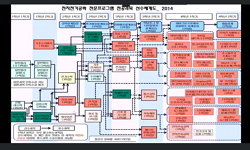We report on the formation of V2O5 semiconductor thin films using rapid thermal annealing (RTA) on sputter-deposited amorphous VOX. DC magnetron sputtering was used to obtain an initial amorphous VOx film on p-Si substrate, followed by O2- and N2-RTA ...
http://chineseinput.net/에서 pinyin(병음)방식으로 중국어를 변환할 수 있습니다.
변환된 중국어를 복사하여 사용하시면 됩니다.
- 中文 을 입력하시려면 zhongwen을 입력하시고 space를누르시면됩니다.
- 北京 을 입력하시려면 beijing을 입력하시고 space를 누르시면 됩니다.
급속 열처리를 이용한 V2O5상의형성 및 V2O5 소자 응용연구 = Formation of V2O5 phase films through RTA and their device application
한글로보기부가정보
다국어 초록 (Multilingual Abstract)
We report on the formation of V2O5 semiconductor thin films using rapid thermal annealing (RTA) on sputter-deposited amorphous VOX. DC magnetron sputtering was used to obtain an initial amorphous VOx film on p-Si substrate, followed by O2- and N2-RTA at two different temperatures of 400 and 500 oC for 3 min. According to X-ray diffraction results, O2-RTA is more effective to achieve the semiconducting phase, V2O5 than N2-RTA, which caused some electrically conducting phases such as V4O9 or V6O13 at 400oC. It is probably because O2 ambient easily supplies O atoms to VOx surface so that the oxide may become the most stable phase. We could postulate from a study of gas-surface interaction on vanadium oxide thin films that in the oxygen ambient the oxygen gas adsorptions on VOx could occur, so the formation of stable V2O5 could be achieved easily particularly at an elevated temperature. The surface microstructure of our VOx film clearly evolves to large-grained structure with the RTA temperature and the resulting rms roughness increases, showing 0.3, 1.2, and 1.5 nm for the cases of as-deposited, 400oC-N2-RTA, and 500oC-N2-RTA, respectively. Our results also show that O2-RTA increases the roughness rather than N2-RTA. In particular, our VOx sample, prepared through 500oC-O2-RTA and proved to be V2O5, appeared to have the most rough surface (Rms roughness= 3.6 nm). With the semiconducting phase V2O5, the AuVOxp-Si always shows rectification while the rectification disappears with metallic vanadium oxide. It is not easy to understand why the Aumetallic VOxp-Si shows an ohmic-like I-V behavior but we presume that the metallic VOx phase may act as a channel through which injected carriers can tunnel between Au and p-Si. It is also interesting to note from the I-V curvesthat the AuVOxp-Si prepared using 500oC-O2-RTA shows higher leakage current than the other two rectifying diodes in spite of the fact that the VOx the most evidently changed to V2O5 according to its XRD result. We report on the formation of V2O5 semiconductor thin films using rapid thermal annealing (RTA) on sputter-deposited amorphous VOX. According to X-ray diffraction results, O2-RTA is more effective to achieve the semiconducting phase. Electrical characterization on Auvanadium oxidep-Si structure exhibited ohmic-like behavior when the thin film mainly contains those metallic phases while the structures were strongly rectifying once the film consists of the semiconducting phase.
국문 초록 (Abstract)
본 논문은 산화바나듐 결정상중 안정적인 상으로 알려져 있는 V2O5 결정상을 사용하여 우선 기본적인 물성을 파악하고 다이오드와 같은 전자소자로서의 응용가능성을 알아보는 것에 목표가 ...
본 논문은 산화바나듐 결정상중 안정적인 상으로 알려져 있는 V2O5 결정상을 사용하여 우선 기본적인 물성을 파악하고 다이오드와 같은 전자소자로서의 응용가능성을 알아보는 것에 목표가 있다. 박막의 증착을 위하여 상온에서 D.C magnetron sputter를 사용하였다. 증착조건에 따라 증착된 박막은 급속열처리가 시행되었다. 금속열처리 조건은 질소 및 산소 분위기에서 400oC ,500oC 였다. 이러한 조건에 따라 박막의 XRD,AFM 등의 구조분석, TLM 등의 전기적 특성 분석을 시행하였다. 이러한 기본적인 물성을 파악하고 다이오드로서의 응용을 위하여 shadow mask를 사용하여 Au 전극을 evaporator에서 증착하여 소자제작을 하였다. XRD 분석을 한 결과 질소분위기, 400oC 에서 V4O9 (~24.74o),V6O13 (~26.98 o)의 조성비를 갖는 금속성의 결정상이 형성되었다. 질소분위기, 500oC 이나 산소분위기 에서는 V2O5(~20.54o) 결정상의 형성이 유리함을 알 수 있었다. 질소보다는 산소분위기에서 V2O5 결정상의 형성이 산소의 추가적인 공급으로 인하여 박막 내에 가스의 흡착으로 인한 것으로 보인다. AFM분석결과 질소분위기보다는 산소분위기에서 더욱 큰 RMS 값을 관찰할 수 있었다. XRD 결과와 일치하는 경향성을 보인 것으로 grain size가 큰 결정질로 변하였음을 알 수 있다.- v - 다음으로 TLM방법을 Au전극을 사용하여 박막의 비저항 값을 측정을 시도 하였다. 열처리에 의하여 감소하는 경향을 나타내었고 이는 비정질에서 결정상으로 상변태가 진행하면서 비저항 값들이 감소하는 것으로 보여 진다. 하지만, 질소분위기, 400oC 에서 금속성들의 상들이 생성되었음을 의미하는 뚜렷한 경향성은 확인 할 수 없었다. 마지막으로 n-type 반도체 특성을 보인다고 보고되어있는 산화바나듐박막을 이용한 p-siVOxAu 다이오드로의 응용을 연구 하였다.질소분위기에서 열처리한 경우, 400oC 에서는 금속성의 산화바나듐 결정상이 생성된다고 미루어 볼 때 옴성의 전류-전압(I-V) 특성을 보인다고 여겨진다. 500oC 에서는 대부분 결정질이 V2O5 인 것으로 다이오드의 정류특성이 산화바나듐박막이 n-type 특성을 보이는 반도체로서의 특성에 기인하는 것으로 보인다. 마지막으로 산소분위기 400oC ,500oC에서 열처리한 경우인 경우 n-type 특성을 보이는 반도체로 알려져 있는 V2O5 결정상 이 생성되므로 다이오드의 정류특성이 산화바나듐박막의 특성에 기인하는 것으로 보인다. 산소분위기에서 열처리한 경우 유리한 다이오드 특성을 보이는 것으로 결론 낼 수 있다. V2O5 결정상을 사용하여 기본적인 물성을 파악하고 다이오드와 같은 전자소자로서의 응용가능성을 대한 연구는 급속열처리의 조건들 즉, 열처리 분위기와 온도에 크게 영향을 받고 산소분위기에서 급속 열처리된 박막의 특성이 최적의 다이오드 공정조건임을 결론내리 수 있다.












